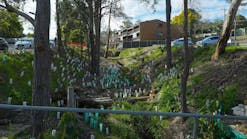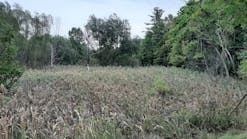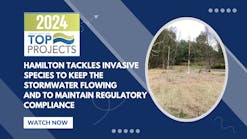An onshore breeze plays over the glittering Pacific Ocean and sends gusts roiling over the rugged Coast Range just north of the Golden Gate. It is summer, and the cool, faintly salt-tinged currents of air tumble through warming grasslands and forests of tan oak, madrone, bay laurel, Douglas fir, and redwood. Here, a scant 10 minutes north of San Francisco, mountain lion tracks dot remote trails, the largest osprey colony in northern California thrives, and endangered peregrine falcons nest on rocky cliffs. In the Bay Area, home to some 6 million people, the network of trails and low-standard roads in the greenways, parks, and watersheds of this rugged peninsula offer rare opportunities for wildland recreation. For many people, this means an exhilarating bike ride.Twenty years ago, no one imagined seeing bikes in the backcountry. Yet today bicycles with strong frames, modified derailleurs, and extended granny gears have given cyclists awesome access to remote and spectacular wildlands.The modern-day mountain bike grew out of a need for a super low-geared bike that could scale 2,571-ft. Mt. Tamalpais, a peak that Bay Area bikers craved to ride. The draw of mountain biking on Mt. Tam put the Marin Municipal Water District’s lands on the map almost overnight, says Casey May, superintendent of watershed resources for the district’s 20,000 ac. The area went from being an out-of-the-way place frequented by hikers and equestrians to a place teeming with people hurrying to the top of Mt. Tam to ride the district’s fire roads back down, sometimes two, three, four, five times a day.Within a few years, the watershed became a regional mountain biking facility, attracting a million visitors a year. But while most cyclists rode down the mountain, others began to explore the remote areas of the watershed, and they could cover as much ground in one hour as a hiker could in one day. Patrolling and safety became serious issues, notes May. Almost overnight, managers of infrastructure and facilities were faced with managing dispersed multiple-use recreation in a 31-mi.2 area. And problems with trail erosion pointed out the need for fresh approaches to trail design and maintenance. Trails Show Where People GoWildland managers such as May know from experience that once a trail is established, people will continue to use it, whether or not good principles were used to locate, design, or construct it. Many of the mountain biking routes had evolved from a loosely joined network of equestrian byways, maintenance roads, scramble trails, and trails built as Depression-era work projects-none of which had been designed with mountain bikes in mind. Their heavy use meant managers had to contend with erosion on switchback cutoffs, fall-line fire roads, section-line and boundary-line trails, and trails that took a straight route to wherever people wanted to go.Guerilla mountain biking trails appeared. A wildlife biologist stumbled across a new trail in northern spotted owl habitat in a pristine portion of the watershed. Dense forest canopy all but concealed a significant amount of earthwork, vegetation removal, and several in-water crossings. If it had been built legally, points out May, the trail would have been subject to stringent environmental regulations.The situation came to a head in the early ’80s when the district put a stop to mountain biking on all the trails and one road in the watershed because of erosion, environmental degradation, and conflicts between mountain bikers, equestrians, and hikers. Everybody was mad, recalls May. An extended interchange began between the district, the mountain biking community, and other trail user groups. Eventually the road was reopened for mountain bike use, but with a 15-mph speed limit. On blind turns and in areas of limited lines of sight, everyone agreed on a limit of 5 mph. Today the district’s 90 mi. of roads are open for mountain biking. The 45 mi. of trails are reserved for hikers and equestrians.Solutions Start With Communication
Trail treads will begin to wear, no matter how well the trail is drained.This first stormy communication became a nucleus of sorts, on which a responsible mountain biking culture could begin to develop in the region. It produced action in the form of information (maps showing designated mountain biking routes were printed and distributed at bike shops), signage (restricted and permitted uses were posted at trailheads), outreach education (mountain bike advocacy groups set up information stations on trails to encourage riders to stay on trails), operations (some trails were closed in winter when they were apt to sustain damage from wet conditions), and volunteer stewardship (mountain bike groups got involved in maintaining trails and removing non-native plants from trail edges). And people got serious about erosion: erosion on roadway surfaces, erosion on fall-line routes, erosion on bandit trails, and the impacts of sedimentation on the biota and functions of streams, wetlands, and waterways. This opened the door wide for managers to reassess design and maintenance standards for the district’s unsurfaced roads that served as multiple-use trails. It got the mountain biking community interested in developing and implementing trail and road design features that were environmentally friendly and could be negotiated by bikers.Look at Drainage Templates
Before they are used recreationally, earthen roads need drainage TLC.“It got us back to basics,” observes May. The district began to take a different look at its inherited road and trail systems and the resource impacts of roads’ drainage designs and uses. In an engineering-based agency, this is not always easy, he laughs. The unintended result of the district’s insloped roads was that the inside ditches concentrated stormwater and delivered sediment directly to streams. Routine ditch maintenance and road blading exposed bare earth and only made the situation worse. Fall-line roads intended as fire breaks experienced chronic erosion. The problem, as with many older road systems, was that erosion prevention and environmental protection had not been high on the agenda when many of the district’s roads were built. And, as in other places where old roads must serve new purposes, managers were forced to deal with trails located in soils and landscape settings where no one would think of putting a trail today.Like anywhere else where old earthen road systems are in use, the tasks of stabilizing and maintaining them can consume too much time and money. Land and resource managers eventually have to ask which roads are needed, which should be closed, and which should be put somewhere else. Luckily, today’s concerns about water quality and aquatic habitats have inspired some good road assessment models. These, and some time-honored technical handbooks, can help managers develop protocols for assessment and sampling wildland roads and trails. Consider Roads’ Zone of InfluenceDepending on their landscape position, roads may serve as sources, sinks, pathways, or barriers to the movement of materials, organisms, and energy through landscapes, according to Fred Swanson et al., whose 1999 paper, “Roads in Forested Landscapes,” was published in Proceedings of the Seventh Biennial Watershed Management Conference. The paper focuses on roads’ zone of influence with respect to impacts on streams and riparian areas. The authors discuss roads as factors in the movement of water, sediment, and debris flows in gravitational flow paths that extend far beyond the road right of way usually considered in road assessment protocols.The authors stratify roads by three slope positions and their related processes and consider how roads function in each zone: (1) within 100 m of ridges, where there is a low frequency of mass movements; (2) on steep hill slopes, where there is a high frequency of erosion and deposition; and (3) on valley floors, where roads on floodplains, terraces, and alluvial fans experience more dynamic conditions than near ridgetops and tend to become net storage sites for upslope sediments. To establish a basis for estimating the benefits of modifying a road system, the authors suggest three scales of assessment. At the first scale, densities of road and stream networks are calculated in length per unit area and areas of high density are identified. At a finer scale, patterns of road-stream intersections are identified to indicate where management action might reduce adverse effects. Finally, at the site level, hillslope positions of roads are considered relative to expected dynamics and probable downslope impacts. Engineering solutions can be selected accordingly.Look at Sediment Delivery Mechanisms
Multiple-use trails require adequate width and sight distance.The United States Forest Service, facing deep funding cuts for a decade or more, has been evaluating thousands of miles of earthen forest roads it formerly maintained in different soils, aspects, elevations, landscape settings, and geologic substrates. Some evaluation methods determine roads’ hydrologic and sediment-delivery impacts on streams. Deciding whether to invest in engineering solutions can be tricky, for not all sediment delivery is bad, and in some cases, very little of the sediment delivered to streams may be manageable by erosion control practices. So it is essential to learn as much as possible about delivery mechanisms for road-related sediments before putting money into decommissioning. Some user-friendly landslide hazard analysis methods have been developed by the Pacific Northwest Region of the Forest Service in support of the President’s Forest Plan, as well as by Weyerhaeuser.Consider Risks Associated With Age of RoadA road’s age can be a general clue to risks and impacts associated with it. The oldest forest roads, those developed for horse logging and later for railroad logging, tend to have the lowest gradients. They are often located on flat ground, can develop problems resulting from wetness, and often interfere with floodplain functions. Full bench and balanced section hillslope roads began to appear after World War II when tractors enabled logging on steeper ground. These roads are often associated with landslides as a result of undercutting, fill failure, recent logging activities, and increased soil-water pressure where compacted fill material impedes downslope-moving groundwater. Ridgeline roads can face long-standing battles with fall-line erosion and occasionally be affected by wind erosion.Design and Implement a Sampling ProgramA road’s drainage template can influence whether the road functions as an extension of the watershed’s drainage network, delivering sediments and water to channels. Insloped roads that drain to ditches and cross-drains have the greatest potential to affect the timing, quantity, and quality of water delivered to streams. But it is important to verify the fate of stormwater discharged from such systems because-depending on landscape position, geology, and soils-much of it could end up reinfiltrating into the ground and not reaching streams at all. For the same reason, road density-or the number of miles of road per square mile of land-cannot always be a reliable indicator of actual delivery of sediment and water to streams. Climate, soil conditions, slope class, and geology each play a part. For this reason, it is essential to develop a sampling strategy to identify high-risk conditions. General erosion risk classes associated with broad geologic groups are as follows: very high risk: mica schist, alluvium, and loess; high risk: granite and siltite; low risk: basalt and quartzite.
Develop and Fund a Maintenance ProgramOutsloped roads allow stormwater to sheet from the road surface onto the shoulder and fill embankment, with little or no effect on the hydrology or the sediment load of streams. But outsloped roads require occasional blading to reshape the travel surface and keep it higher than the shoulder. When such maintenance is deferred on an actively used, outsloped road, the road runs the risk of developing lengthwise drainage as stormwater concentrates in wheel ruts. If other drainage features, such as rolling dips and grade breaks, are not present on the road, an unmaintained, outsloped roadway can become an erosion nightmare. As the following table shows, road width influences how long water may run on an outsloped road before it reaches the edge of the road shoulder.A glance at Table 1 reveals in a heartbeat that the width of nonsurfaced roads and the degree of outsloping have tremendous influences on the linear distance that stormwater will travel on a road before leaving it. Let’s say we have a 24-ft.-wide road at a 6% gradient and outsloped at 2%. Stormwater will travel 76 ft. down this road. But if the road can be reconstructed as a 14-ft.-wide road at the same gradient but with a 5% outslope, the travel distance for stormwater can be cut to 22 ft. or reduced by 71%.
Evaluate OptionsThis is the kind of data that, when put together with specific findings about hillslope processes and road impacts, can inspire managers to consider road reconstruction, decommissioning, or closure. Some entities, such as the Marin Municipal Water District and the North Coast Redwoods District of California State Parks, consider a fourth option: the reconstruction of roadway surfaces to narrower, outsloped trails. This decommissioning option relies on the same techniques as for full-scale road decommissioning: brushing and grubbing of vegetation on the cutbank, road surface, and fill slope; ripping the inside ditch; pulling sidecast fill material up onto the road surface; recontouring the newly placed fill; and mulching, seeding, revegetating, or broadcasting slash on the recontoured slope. In their 1999 Road Decommission Monitoring Report for the Mount Adams Ranger District of the Gifford Pinchot National Forest, authors Coffin, Defoe, and KcKeone identify eight basic objectives and six techniques for decommissioning roads, as summarized in Tables 2 and 3.
Develop Design Standards for Multiple UsesWhen managers decide to reconstruct or manage a road as a multiple-use trail, they must consider width, clearing limits, sight distance, pullouts, turn radii, grade breaks, drainage, and maintenance. But the overarching consideration, according to Mike Riter, president of Trail Design Specialists, is that if the trail is built right, it can be used forever. Riter, who travels the world teaching people how to build and maintain trails, believes we can’t know how trail uses are going to change in the future. For this reason, he stresses that every trail should be designed and constructed with multiple uses in mind.Riter identifies three classes of mountain bike use: (1) the family wanting to ride 5 mi. or less, at a gentle gradient, with pitches not to exceed 5-8%; (2) the intermediate rider looking for a 5- to 12-mi. outing with an overall gradient not exceeding 10%; and (3) the advanced rider looking for 10-40 mi. a day, with sustained grades no steeper than 10%. As it turns out, these grades are not very different from those required by beginning, intermediate, and advanced hikers and by equestrians. In any case, notes Riter, riders, like hikers and equestrians, are looking for awesome aesthetics, good flow, and workable turn radii. These, he says, are easy to provide for bicycles while meeting the needs of hikers and equestrians. Many little design details, such as crowding the edge of the trail with a large rock, can be used to keep users in check without being obtrusive, Riter points out.Drain and MaintainNo matter what their use, trails need to be drained and maintained in order to continue functioning. A good place to begin is with a trail surface outsloped at about 5%. Rolling grade breaks need to be friendly to the radius of a wheel and should not present an obstacle to riders. In side view, they resemble an overturned, elongated spoon, describes Riter, with the handle straightened and pointing down the trail. The gradual grade reversal forces water off the trail but keeps bicycles on it.Where water bars already exist or must be used, some trail managers like to leave a gap on the upslope side of the trail where riders can pass through. But unless the gap is reinforced, it can wear down and cause the water bar to fail. Wooden and rubber water bars can pose hazards for cyclists and horses. If the water bar is angled at 45º or greater to the trail and drains at about 20% of gradient, runoff will transport sediments carried off the trail surface. The runoff is routed into a flat spot or against a barrier, such as a downed log, where sediments can settle out. The rock and gravel that form the interior structure of the water bar must be keyed below the tread surface, with only one-third to one-half of the bar extending above the trail surface.Gordon Keller, geotechnical engineer for Region V of the US Forest Service, favors rolling dips to control erosion on earthen roads and trails. “For low-volume roads, a rolling dip is the most cost-effective maintenance mechanism there is. They are cheap to build, cheap to maintain, and don’t blow out.” As with water bars, rolling dips need to be spaced frequently, according to soils, climate, hillslope position, groundwater conditions, and gradient of the trail. Table 4 prescribes spacing for water bars and rolling dips in various soils in the upper topographic position of a northeast-facing slope with a cross-slope of 80%.
It is easy to see that for all but the rockiest materials, the starting point for drainage relief on a multiple-use trail on 10% gradient is one or more water bar per 100 ft. This should be a rule of thumb for every drainage design, Keller emphasizes.Incorporate Drainage Into Fall-Line SectionsBut even the best-constructed trail will wear down in the center area, states Jim Jacobsen, who designs, constructs, and maintains specialty cross-country trails for cyclists looking for flow, tight turn rhythms, and a challenging experience. Jacobsen has been rewriting the book on vertical challenge for mountain bikers by building horizontal turns that don’t demand steep, fall-line routes to provide a thrill. His coup d’état is an 8-mi. system in a Boy Scout camp with a rolled grade mostly less than 8% and 45 switchbacks and climbing turns. The course takes skill and keeps the rider always turning.When he uses the fall line, Jacobsen likes to slalom off it in frequent, tight S-bends that require control and skill and give the water a chance to get off the trail. Frequent grade reversals are critical to drain the tread, he maintains, but they need to be transparent to a bike wheel, “not an abrupt ditch you drop into and knock your fillings out.” Fine-tuning is essential to the sustainability of trails, stresses Jacobsen. He works with volunteers to identify the route, noting the natural landscape depressions where drainage features will be placed. They construct the trail to about 98% completion, then monitor and tweak it until it is just right. A soft spot might need to be armored by pounding fist-size and smaller rock into a matrix of earth, or the turning radius of a switchback might need revising. “Don’t build it and walk away,” he insists. “See what you didn’t get quite right, and fix it.”Trail designer Mike Riter puts it this way: “Water always wins. The trick is not letting it play the game.”





